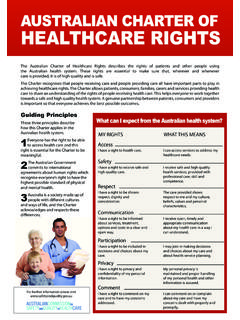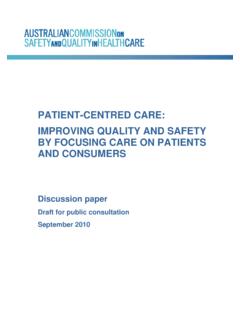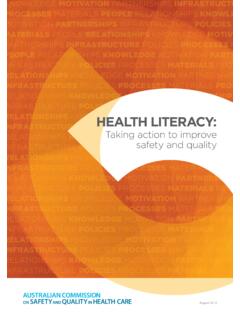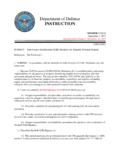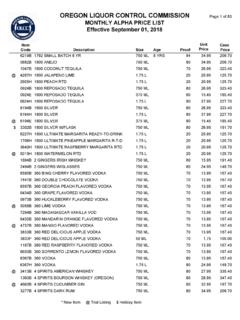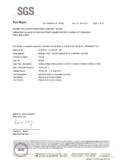Transcription of National Safety and Quality Health Service Standards
1 National Safety and Quality Health Service StandardsSeptember 2011 National Safety and Quality Health Service Standards , September 2011 Endorsed by Australian Health Ministers September 2011 ISBN: 978-1-921983-04-7 Suggested citation: Australian Commission on Safety and Quality in Health Care (ACSQHC) (September 2011), National Safety and Quality Health Service Standards , ACSQHC, Sydney. Commonwealth of Australia 2011 This work is copyright. It may be reproduced in whole or in part for study or training purposes subject to the inclusion of an acknowledgement of the source. Requests and inquiries concerning reproduction and rights for purposes other than those indicated above requires the written permission of the Australian Commission on Safety and Quality in Health Care:Australian Commission on Safety and Quality in Health CareGPO Box 5480 Sydney NSW 2001 Email: document was prepared by the Australian Commission on Safety and Quality in Health Care in collaboration with numerous expert working groups and members of the Commission s standing committees who generously gave of their time and expertise.
2 Thanks also go to the numerous individuals and organisations, Health services , practitioners, consumers, managers and Health departments who have provided the feedback that made these Standards Safety and Quality Health Service Standards | 1 ContentsIntroduction 3 Roles for Safety and Quality in Health Care 6 Terminology 7 Standard 1 Governance for Safety and Quality in Health Service Organisations 14 Standard 2 Partnering with Consumers 22 Standard 3 Preventing and Controlling Healthcare Associated Infections 26 Standard 4 Medication Safety 34 Standard 5 Patient
3 Identification and Procedure Matching 40 Standard 6 Clinical Handover 44 Standard 7 Blood and Blood Products 48 Standard 8 Preventing and Managing Pressure Injuries 54 Standard 9 Recognising and Responding to Clinical Deterioration in Acute Health Care 60 Standard 10 Preventing Falls and Harm from Falls 66 Appendix 1 72 References 73 The Hon Dr Kim Hames Chair, Australian Health Ministers Conference Minister for Health AHMC Secretariat PO Box 344 RUNDLE MALL SA 5000 Dear MinisterThe National Safety and Quality Health Service StandardsOn behalf of the Commission, I am honoured to submit the National Safety and Quality Health Service Standards for the consideration of Health Ministers.
4 The Commission developed the Standards following extensive public and stakeholder consultation. The Standards are a critical component of the Australian Health services Safety and Quality Accreditation Scheme endorsed by the Australian Health Ministers in November Standards provide a nationally consistent and uniform set of measures of Safety and Quality for application across a wide variety of Health care services . They propose evidence-based improvement strategies to deal with gaps between current and best practice outcomes that affect a large number of patients. The Standards address the following areas: Governance for Safety and Quality in Health Service Organisations Partnering with Consumers Preventing and Controlling Healthcare Associated Infections Medication Safety Patient Identification and Procedure Matching Clinical Handover Blood and Blood Products Preventing and Managing Pressure Injuries Recognising and Responding to Clinical Deterioration in Acute Health Care Preventing Falls and Harm from FallsThe Standards are designed to assist Health Service organisations to deliver safe and high Quality care.
5 The document presents the ten National Safety and Quality Health Service Standards and details the tasks required to fulfil them. I acknowledge the contribution, effort and enthusiasm of the many clinicians, managers, consumers and organisations involved in their development. And I commend the diligence and commitment of our staff who developed sincerelyWilliam J Beerworth Chair 19 May 2011 National Safety and Quality Health Service Standards | 3 IntroductionAustralian Commission on Safety and Quality in Health CareThis document presents the ten National Safety and Quality Health Service (NSQHS) Standards . The NSQHS Standards were developed by the Australian Commission on Safety and Quality in Health Care (ACSQHC) in consultation and collaboration with jurisdictions, technical experts and a wide range of stakeholders, including Health professionals and patients.
6 The primary aims of the NSQHS Standards are to protect the public from harm and to improve the Quality of Health Service provision. They provide a Quality assurance mechanism that tests whether relevant systems are in place to ensure minimum Standards of Safety and Quality are met, and a Quality improvement mechanism that allows Health services to realise aspirational or developmental goals. Accreditation is recognised as an important driver for Safety and Quality improvement and Australia s Health accreditation processes are highly regarded internationally1. The Standards are integral to the accreditation process as they determine how and against what an organisation s performance will be assessed. The Standards have been designed for use by all Health services .
7 Health Service organisations can use the Standards as part of their internal Quality assurance mechanisms or as part of an external accreditation process. National Safety and Quality Health Service Standards 1. Governance for Safety and Quality in Health Service Organisations which describes the Quality framework required for Health Service organisations to implement safe Partnering with Consumers which describes the systems and strategies to create a consumer-centred Health system by including consumers in the development and design of Quality Health Preventing and Controlling Healthcare Associated Infections which describes the systems and strategies to prevent infection of patients within the healthcare system and to manage infections effectively when they occur to minimise the Medication Safety which describes the systems and strategies to ensure clinicians safely prescribe.
8 Dispense and administer appropriate medicines to informed Patient Identification and Procedure Matching which describes the systems and strategies to identify patients and correctly match their identity with the correct Clinical Handover which describes the systems and strategies for effective clinical communication whenever accountability and responsibility for a patient s care is Blood and Blood Products which describes the systems and strategies for the safe, effective and appropriate management of blood and blood products so the patients receiving blood are Preventing and Managing Pressure Injuries which describes the systems and strategies to prevent patients developing pressure injuries and best practice management when pressure injuries Recognising and Responding to Clinical Deterioration in Acute Health Care which describes the systems and processes to be implemented by Health Service organisations to respond effectively to patients when their clinical condition deteriorates.
9 10. Preventing Falls and Harm from Falls which describes the systems and strategies to reduce the incidence of patient falls in Health Service organisations and best practice management when falls do occur. Introduction4 | National Safety and Quality Health Service StandardsAustralian Commission on Safety and Quality in Health CareThe NSQHS StandardsStandard 1 Governance for Safety and Quality in Health Service Organisations and Standard 2 Partnering with Consumers set the overarching requirements for effective implementation of the remaining eight Standards , which address specific clinical areas of patient care. Standard 1 provides the Safety and Quality framework by outlining the expected structures and processes of a safe organisation.
10 Standard 2 requires effective and meaningful engagement of patients in the review, design and implementation of services as there is evidence that suggests that engaging patients can result in improved Safety , Quality and efficiency. The Standards address areas in which there are: a large number of patients involved known gaps between the current situation and best practice outcomes existing improvement strategies that are evidence-based and achievable. Content of the NSQHS Standards Each Standard contains: the Standard, which outlines the intended actions and strategies to be achieved a statement of intent, which describes the intended outcome for the Standard a statement on the context in which the Standard must be applied a list of key criteria; each criterion has a series of items and actions that are required in order to meet the and developmental actionsThe Standards apply to a wide variety of Health services .
